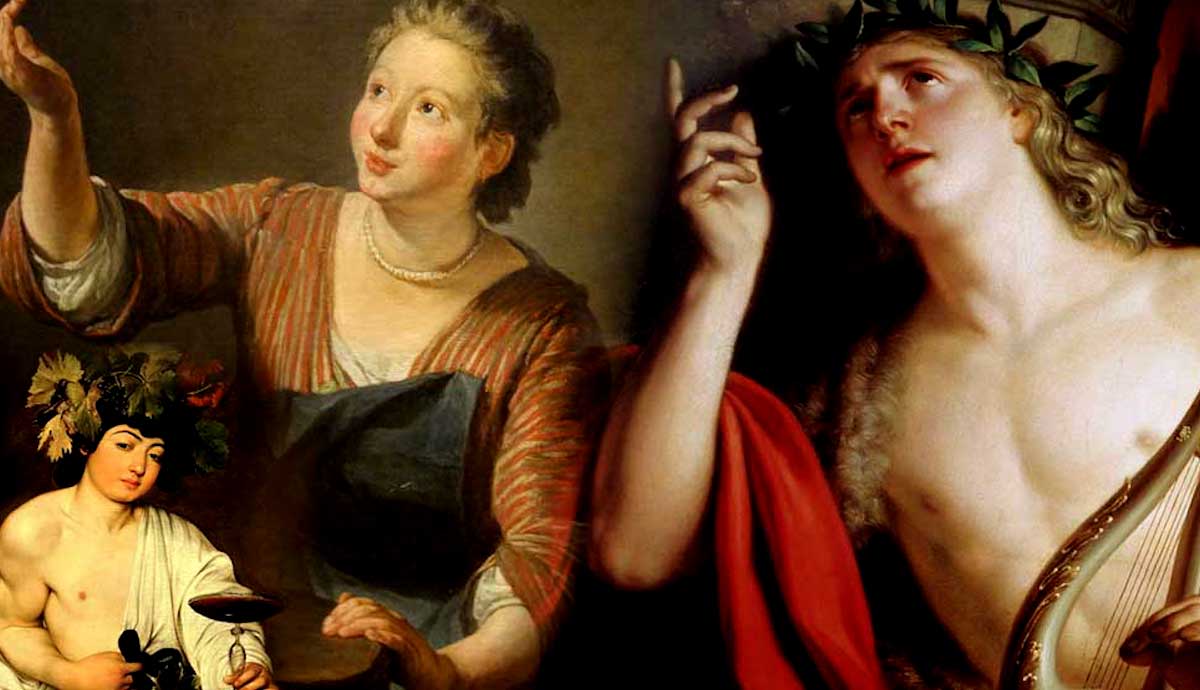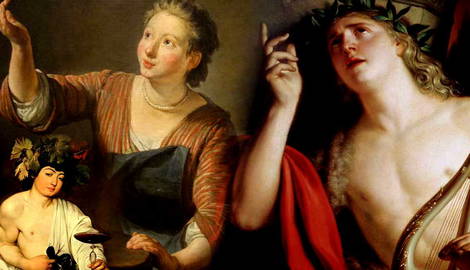
In Greek mythology, the Titans beguiled the infant Dionysus with toys before killing him. They cut him into pieces, but he was reborn from the thigh of Zeus. What were the rites of the cult of Dionysus, and the significance of these toys?
A Brief History of the Cult of Dionysus

In a myth related to the ancient Greek mystery cult of Orphism, the Titans used a collection of toys — a mirror, golden apples, knucklebones, dolls, and spinning toys (a kohnos, and a rhombos) — to divert infant Dionysus’ attention from the powers which Zeus had granted him, and successfully lure him. After cutting Dionysus into small pieces, they boiled him and ate his flesh. However, Athena saved his beating heart and sent it to Zeus. The father of the gods sewed it into his thigh, from which Dionysus was reborn.
The earliest evidence of Dionysus’ worship comes from some 2nd century BCE tablets found in Crete. Even though their origins are unknown, Dionysian mysteries are likely to have come to Greece during the importation of wine from either Mesopotamia or North Africa.
The cult of Dionysus, known as the wine cult, had close associations with the understanding of the natural cycle of the grapevine. Since the Greeks believed that the intoxicating effects of the drink embodied the spirit of Dionysus’ savage character, they worshipped him fondly with wine-induced dances and loud, drunken entertainments. The most prominent event that the ancient Greek world dedicated to him was the Great Dionysia, a multi-day festival in Athens, which hosted comedy and tragedy competitions among famed writers and poets.
The Rites of Dionysus

The rites associated with the cult of Dionysus remain a mystery, and the secrecy surrounding the festival has been more successful than Eleusis. Since ancient Greek wine included honey, herbal, and floral ingredients, cultivation of these got also incorporated into the cult of Dionysus. The bull, whose horns used to be wine-drinking vessels, and the goat, as the natural pruner of the vineyards, were also primary animals celebrated by the cult.
The themes of seasonal death and rebirth are central components of vegetation cults. However, the cult of Dionysus was unlike the others because of its distinctive emphasis on spirit possession and atavism. An ancient instrument, the bullroarer, was used to evoke the spirits, followed by the initiates dancing to drums in a trance state. The cult was atavistic: the spirit possessions were not the work of a Greek god but of bestial entities, and the initiates believed that they could transform into animals.
“Following the torches, as they dipped and swayed in the darkness, they climbed mountain paths with head thrown back and eyes glazed, dancing to the beat of the drum which stirred their blood. In the state of ecstasy, they abandoned themselves, dancing wildly and calling ‘Euoi!‘ At that moment of intense rapture, they became identified with the god himself…. They became filled with his spirit and acquired divine powers“.
Peter Hoyle, Delphi, p.76 (London: 1967).
Orphics Mysteries and Dionysus

Following the conquests of the Alexander the Great, Greek belief systems began to spread to other parts of the world. The cult of Dionysus became associated with deities such as the Osiris of the Egyptians and the Baals of the Palestinians. As these connections feedbacked to Greece with time, the cult changed into an increasingly complex unit. These changes diverted the cult of Dionysus from its mystical form and turned it into a substantial component of the Orphic Mysteries.
Orphism was one of the various belief systems of ancient Greece, and its followers were called the Orphics. The scarce information about Orphism makes it problematic to define its boundaries among other religious and philosophical practices. In its early days, the Orphic tradition was heavily influenced by the Eleusinian rites, and it adapted rituals from other myths as its own. Omophagia (the eating of raw food, especially meat) became the focus of the Dionysian rites.
The Orphics initiated the mysterious Eleusinian festival every year to celebrate Demeter, but their strong interest was in Dionysus. Unlike the cult of Eleusis, Orphism existed without the need for a sanctuary, and it lacked a stable priesthood.

The death of the infant Dionysus has been attached to Orphism because The Orphic Rhapsodies narrate the same myth. Just like the crushed grapes used for winemaking, he was savagely dismembered. The Rhapsodies emerged in the Hellenistic period, but the poem’s history goes back to the 5th century BCE as it had absorbed songs from much earlier periods. The Rhapsodies were generally recognized as the work of the Thracian poet and musician Orpheus.
He described the dances of Curetes around the cradle of Dionysus while the Titans tricked him with toys before tearing, boiling, and eating him. Zeus punished the Titans for their sparagmos (tearing Dionysus apart) and struck them with thunderbolts because he had appointed his son Dionysus to become his successor. From the blood and the soot of the Titans, humans originated. Because of their origin, the human souls had a divine component in them, a gift from Dionysus. They also projected evil for being the descendants of the Titans.
The Significance of the Toys of Dionysus
The Mirror

Kore was not a baby when Hades snatched her to the underworld. Nevertheless, Dionysus shared a similar fate with her before the Titans ripped him apart. In the Homeric Hymns, while Kore is playing in a meadow, a beautiful flower distracts her. She reaches out to it with amazement, but something terrible happens: Hades springs out of the earth and seizes the maiden.
In Greek, this distracting flower was called a beautiful toy. Besides, the fascination of the infant god, as he gazed at his reflection in the mirror, had parallels to Kore’s reaction when she noticed the beautiful flower that led her to the lower realms. Greeks believed that the mirror was a symbol of aptitude: Dionysus was distracted not only by his image but also by his intellectual wisdom.
The Golden Apple

In the myth, golden apples exist only in the garden of Hesperides, and they grant immortality to those who eat them. Since immortality belongs to the Gods, mortals are not allowed to have them: these beautiful, solid gold fruits are desirable, but one should never seek after them. In the myth of Dionysus, they symbolize his resurrection; he died each winter and was reborn in the spring.
Also, in Greek mythology, golden apples represent the core of a dispute that will unlikely to resolve, known as the apple of discord. During a feast of the gods, goddess Eris threw an apple in the air and said: “to the most beautiful.” Three goddesses, Hera, Athena, and Aphrodite, competed to win it as a prize for their beauty, but in the end, their wrath led to the Trojan war.
Knucklebones

It is evident from the abundant archeological evidence that these were popular toys in antiquity. Not only have sets of knucklebones been excavated, but the knucklebone game itself- played by children, women, and men- was often depicted in painting and sculpture. Knucklebones have been referred to as toys with moving limbs or puppets, which the baby Dionysus must have found engaging.
Plato describes the following:
“Let us suppose that each of us living beings is puppets of the Gods, either their plaything only or created with a purpose – which of the two we cannot certainly know. But we know that these inward affections of ours, like cords and strings, pull us towards different and opposite ways and to opposite actions, and herein lies the difference between virtue and vice. We ought always to co-operate with the lead of the best, which is the law. And thus, the moral of the tale about our being puppets will not have been lost.”
(The Laws 1.645)
Kohnos and Rhombos (Spinning Toys)

In the Orphic verses, kohnos and rhombos are always written in the same order. The grouping of these words possibly indicates that they were a fixed set of toys. Even though rhombos is known as the bullroarer, the meaning of kohnos is unclear. The pairing might mean that it was possibly a spinning top, not a pine cone as often suggested. The initiates ornamented these toys with Dionysiac motifs and used them as votive offerings during the rites of Dionysus. Ancient writers of Dionysian mysteries mention these toys often because of their sound: the sound they made was so remarkable that it sometimes resembled thunder, i.e., Zeus. Noise and spinning are part of the cult of Dionysus. He was often loud and known as “the roarer.”

The toys of Dionysus were powerful reminders for the initiates of the infant Dionysus’s play and terrifying death. The evidence suggests that the initiates took these objects after the rituals and kept them in their homes to worship, as they were the reminders of their initiation and acquired wisdom. A conversation between Plutarch and his wife over the death of their daughter echoes the influence of these tokens. Plutarch tells his wife that the dead does not suffer and that she should no longer grieve. He fails to convince her, as her faith in the toys of Dionysus is unchangeable.
“Once freed from the body, the soul suffers no inconvenience or evil, nor is it sensible at all. I know that you are better grounded in the doctrines delivered down to us from our ancestors, as also in the sacred mysteries of Dionysus, than to believe such stories; for the mystic symbols are well known to us who are of the fraternity.”
(Consolatio ad Uxorem 10, 611d)










